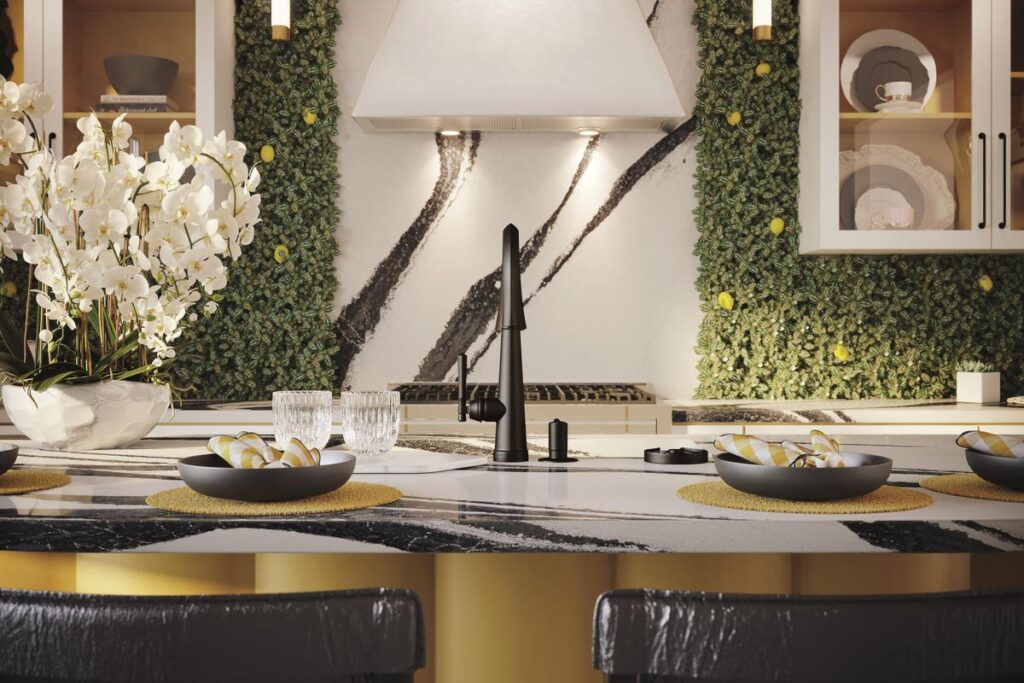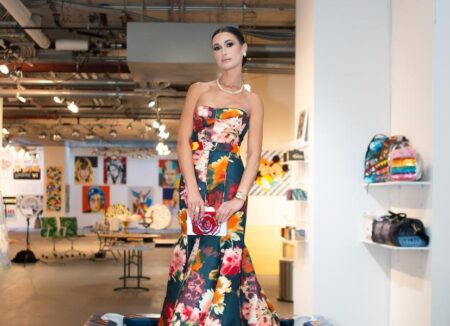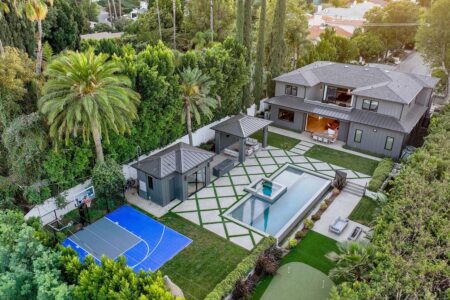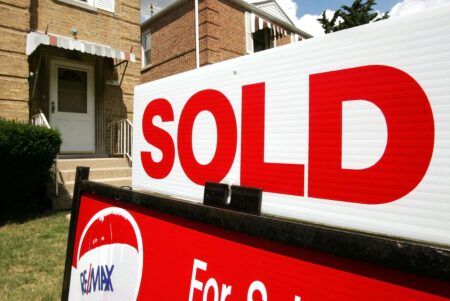There are many ways to track home design trends. One of the best is considering what retailers are seeing specifiers and homeowners purchasing – especially retailers that cater to both professional and consumer clientele across the country, like the Ferguson Bath, Kitchen & Lighting Gallery chain and its Build with Ferguson website.
Here are five of their latest residential trends showing an increasing focus on wellness, along with what they signify, and related insights from designers who shared their own experiences via professional social media groups and email.
Biophilic Intention
Biophilia literally translates to love of living elements, and signifies design elements that are inspired by nature and/or incorporate natural materials. The purpose is to provide a nurturing, relaxing space for occupants.
“Think biomimicry: wallpapers, leafy tile designs, art echoing nature, and marble with water-like color and pattern. Play with living finishes on wood and metals and enjoy the beauty of organic shapes,” suggests Seattle-based kitchen designer Paula Kennedy. “Though our natural urge is to connect with nature, we’re indoors 87% of the time,” she adds. “Inviting the outdoors inside becomes vital.”
“One way to do that includes maximizing natural sunlight whenever possible,” notes New York designer Isfira Jensen. “Another way is to select natural materials. Finally, I incorporate indoor plants throughout the home whenever possible.”
Wetroom Bathrooms
This trend combines tub and shower in a single space — usually the home’s primary bathroom — rather than in a single fixture, like the tract home tub/shower combinations many of us grew up with. The wetroom takes advantage of surfacing materials designed to handle water and slip resistant flooring, as well as maximizing space and potentially adding accessibility with roll-in entry to the shower section of the bathroom.
“Wet bathrooms are becoming increasingly popular in our interior design projects. The traditional notion of separating dry and wet areas in a bathroom is evolving as clients seek more versatile spaces,” notes Alberta, Calgary area designer Michelle Fleischhacker. “The open and most often-barrier free layout of wet bathrooms can help our clients ‘future-proof’ their spaces should they encounter mobility challenges down the road. Without the need to step over a bathtub or into a shower enclosure, entry and movement are more straightforward,” the Canadian professional adds.
“Wet rooms can overcome the constraints of narrow dimensions in bathrooms, providing homeowners with more amenities in the same footprint,” observes Seattle area designer Molly McCabe. She cautions though, for remodeling projects, they “require very careful planning and often engineered stamped permit drawings, also local building code knowledge.”
Eco-mindfulness
Sustainability is a definite benefit of eco-mindful design, but so is creating healthier home interiors. The EPA says our indoor air can be five times more polluted than the air outdoors. That creates an imperative for designers to choose materials that do not off-gas into a room, (that is releasing chemical gases that can be unsafe and unhealthy for occupants.)
Palm Beach area designer Denise Jadd welcomes this trend. “By embracing this approach, we are prioritizing our clients’ health and wellness at home as we navigate through the selections to choose better materials, and address their health concerns as non-toxic materials eliminate harmful chemicals and fumes that can be detrimental to our respiratory system.”
There’s a challenge for professionals and homeowners alike in sorting through the myriad claims that fall into both ‘green-washing’ and ‘well-washing’ claims. “Covid accelerated our industry to produce healthier products, and consumers are buying based on company core product values to the environment,” observes Denver-based kitchen designer Jan Neiges. “The challenge has been in finding one source that can both sanction these products and provide a directory of companies that adhere to that. We have so many labels; we need one that all the sub-labels can fall under, making it easy for professionals to help clients.”
Multi-sensory Design
This trend is about appealing to multiple senses, rather than just what can be seen. This can include embracing the tactile with textured surfaces, surrounding a space with soothing sounds (and blocking out exterior noises), filling a room with fragrant flowers and, of course, providing beauty.
Kennedy offers these multi-sensory examples that can be achieved with design elements and planning: “Observing the shifting interplay of light and shadows with the sun’s journey, experiencing the gentle breeze through an open window, listening to the soothing melody of trickling water, and embracing the textures of natural woods, living finish metals, and organic fibers that surround us. These components collectively bridge the gap to nature, providing a grounding, calming, and holistic physical, mental, emotional, and spiritual healing.”
“The essence of a home lies not just in its appearance but in how it feels, sounds, and even smells,” observes Dallas-based interior designer Brad Smith. “I consider factors like acoustics – using soft furnishings to reduce noise pollution, and aromatherapy – recommending scents that relax or energize, based on the function of the room. Touch also plays a part – from smooth countertops in kitchens to plush carpets in bedrooms, each texture evokes a different sensation.”
Technical Support
Smart home technology is providing numerous opportunities for making our homes safer, healthier and more functional. These can include indoor air quality monitoring, leak detection, automated window coverings for light control , hands-free faucets for reduced germ spread and much more.
“Technology is transforming the way homeowners live today, offering convenience, efficiency, security, and a higher quality of life,” declares San Francisco Bay area designer Sheeja Nair. “A lot of our projects include smart, motorized window treatments that can be completely automated, or operated with a mobile device or a voice assistant.” Her client favorites include lighted smart mirrors, touchless faucets, and motion-sensing lighting.
“We use smart home lighting system setup to mimic natural lighting patterns to regulate circadian rhythms. This lighting technology helps clients improve sleep quality and mood in a noticeable way,” Jensen shares.
Fleischhacker’s older clientele are also embracing technology, she notes. “From newer technology such as ovens that provide recipe suggestions to simple wi-fi enabled thermostats and safety-centric sensor lighting, technology is changing how our clients experience their homes. We can personalize their spaces with everything from refrigerators that help them manage grocery lists to hands-free faucets and self-cleaning toilets. We find it is a win-win for clients to feel pampered within their own home while family members are comforted by the safety features afforded by technology.”
Read the full article here













